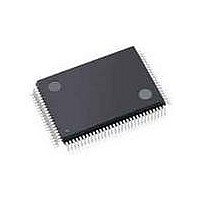C8051F040-TB Silicon Laboratories Inc, C8051F040-TB Datasheet - Page 180

C8051F040-TB
Manufacturer Part Number
C8051F040-TB
Description
BOARD PROTOTYPING W/C8051F040
Manufacturer
Silicon Laboratories Inc
Type
MCUr
Specifications of C8051F040-TB
Contents
Board
Processor To Be Evaluated
C8051F04x
Interface Type
USB
Lead Free Status / RoHS Status
Contains lead / RoHS non-compliant
For Use With/related Products
C8051F040
Lead Free Status / Rohs Status
Lead free / RoHS Compliant
- Current page: 180 of 328
- Download datasheet (3Mb)
C8051F040/1/2/3/4/5/6/7
3/4/5) and all locations above 0x8000 (C8051F046/7) are reserved. Flash writes and erases targeting the
reserved area should be avoided.
Table 15.1. Flash Electrical Characteristics
V
15.2. Non-volatile Data Storage
The Flash memory can be used for non-volatile data storage as well as program code. This allows data
such as calibration coefficients to be calculated and stored at run time. Data is written using the MOVX
write instruction (as described in the previous section) and read using the MOVC instruction.
An additional 128-byte sector of Flash memory is included for non-volatile data storage. Its smaller sector
size makes it particularly well suited as general purpose, non-volatile scratchpad memory. Even though
Flash memory can be written a single byte at a time, an entire sector must be erased first. In order to
change a single byte of a multi-byte data set, the data must be moved to temporary storage. The 128-byte
sector-size facilitates updating data without wasting program memory or RAM space. The 128-byte sector
is double-mapped over the 64k byte Flash memory; its address ranges from 0x00 to 0x7F (see
Figure 15.1). To access this 128-byte sector, the SFLE bit in PSCTL must be set to logic 1. Code execution
from this 128-byte scratchpad sector is not permitted.
15.3. Security Options
The CIP-51 provides security options to protect the Flash memory from inadvertent modification by soft-
ware as well as prevent the viewing of proprietary program code and constants. The Program Store Write
Enable (PSCTL.0) and the Program Store Erase Enable (PSCTL.1) bits protect the Flash memory from
accidental modification by software. These bits must be explicitly set to logic 1 before software can write or
erase the Flash memory. Additional security features prevent proprietary program code and data constants
from being read or altered across the JTAG interface or by software running on the system controller.
A set of security lock bytes stored at 0xFDFE and 0xFDFF (C8051F040/1/2/3/4/5) and at 0x7FFE and
0x7FFF (C8051F046/7) protect the Flash program memory from being read or altered across the JTAG
interface. Each bit in a security lock-byte protects one 8k-byte block of memory. Clearing a bit to logic 0 in
a Read Lock Byte prevents the corresponding block of Flash memory from being read across the JTAG
interface. Clearing a bit in the Write/Erase Lock Byte protects the block from JTAG erasures and/or writes.
The Read Lock Byte is at locations 0xFDFF (C8051F040/1/2/3/4/5) and 0x7FFF (C8051F046/7). The
Write/Erase Lock Byte is located at 0xFDFE (C8051F040/1/2/3/4/5) and 0x7FFE (C8051F046/7).
Figure 15.1 shows the location and bit definitions of the security bytes. The 512-byte sector containing
the lock bytes can be written to, but not erased by software. An attempted read of a read-locked byte
returns undefined data. Debugging code in a read-locked sector is not possible through the JTAG inter-
face.
180
Flash Size
Endurance
Erase Cycle Time
Write Cycle Time
Notes:
DD
1. Includes 128-byte scratchpad.
2. 512 bytes at locations 0xFE00 to 0xFFFF are reserved.
= 2.7 to 3.6 V; T
Parameter
1
a
= –40 to +85 °C
C8051F040/1/2/3/4/5
C8051F046/7
Conditions
Rev. 1.5
20 k
Min
10
40
65664
32896
100 k
Typ
12
50
2
Max
14
60
—
Erase/Write
Units
Bytes
ms
µs
Related parts for C8051F040-TB
Image
Part Number
Description
Manufacturer
Datasheet
Request
R
Part Number:
Description:
SMD/C°/SINGLE-ENDED OUTPUT SILICON OSCILLATOR
Manufacturer:
Silicon Laboratories Inc
Part Number:
Description:
Manufacturer:
Silicon Laboratories Inc
Datasheet:
Part Number:
Description:
N/A N/A/SI4010 AES KEYFOB DEMO WITH LCD RX
Manufacturer:
Silicon Laboratories Inc
Datasheet:
Part Number:
Description:
N/A N/A/SI4010 SIMPLIFIED KEY FOB DEMO WITH LED RX
Manufacturer:
Silicon Laboratories Inc
Datasheet:
Part Number:
Description:
N/A/-40 TO 85 OC/EZLINK MODULE; F930/4432 HIGH BAND (REV E/B1)
Manufacturer:
Silicon Laboratories Inc
Part Number:
Description:
EZLink Module; F930/4432 Low Band (rev e/B1)
Manufacturer:
Silicon Laboratories Inc
Part Number:
Description:
I°/4460 10 DBM RADIO TEST CARD 434 MHZ
Manufacturer:
Silicon Laboratories Inc
Part Number:
Description:
I°/4461 14 DBM RADIO TEST CARD 868 MHZ
Manufacturer:
Silicon Laboratories Inc
Part Number:
Description:
I°/4463 20 DBM RFSWITCH RADIO TEST CARD 460 MHZ
Manufacturer:
Silicon Laboratories Inc
Part Number:
Description:
I°/4463 20 DBM RADIO TEST CARD 868 MHZ
Manufacturer:
Silicon Laboratories Inc
Part Number:
Description:
I°/4463 27 DBM RADIO TEST CARD 868 MHZ
Manufacturer:
Silicon Laboratories Inc
Part Number:
Description:
I°/4463 SKYWORKS 30 DBM RADIO TEST CARD 915 MHZ
Manufacturer:
Silicon Laboratories Inc
Part Number:
Description:
N/A N/A/-40 TO 85 OC/4463 RFMD 30 DBM RADIO TEST CARD 915 MHZ
Manufacturer:
Silicon Laboratories Inc
Part Number:
Description:
I°/4463 20 DBM RADIO TEST CARD 169 MHZ
Manufacturer:
Silicon Laboratories Inc










